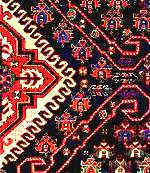|
|
It is a long time since Caucasia weavings have been one of the most valuable handmade among Eastern Carpets. It must be said, that fine wool, bright and vivid colors, as well as correct method of weaving, made kilims of this region valuable. Caucasia kilim weavers use merino wool of Georgia, which is the best.
Caucasia is a mountain region with cold climate. Because of its special situation, it is a bridge between East and West. As Caucasia is a suitable passage, and different races with different nationalities might live in, made people’s culture of this region to be hurt.
Caucasian texture had a flourishing era, when Russian govern this region, because of trading with other countries. These trades not only increased production, but also caused weavers to be acquainted with chemical dyes. Easiness of using these dyes, made those become very common among Caucasian. Gradually, traditional use of natural dyes, with high quality, has been forgotten and stood aside.
Weaving has an important role in Caucasian culture. Carpets are mostly woven by women, and weaving is one of The Social Traditions of Caucasia. Girls become familiar with methods of weaving by their mothers, when they are only a child, and weave carpets for their dowries. In Caucasian societies, women, specially mothers, have important situation in family. In many areas of this region, Star Shapes are engraved on main columns of the house, which is a symbol of “mother” in family.
Kilim is used for many different purposes, such as: carpet, curtain, wall-hanger, cushion, yastic and tent of cart. Other usage of kilim, which is in the shape of bag, is used for keeping cereals, food and necessaries; and also “mafrash” for keeping clothes and bedding. Caucasia kilim is very common for its composition, in all regions, except in Georgia and Nargoni, Karibak. Human bodies, working domestic animals and imaginary and mythical animals compositions, are seen in these kilims.
Kuba
Kuba is one of the most important kilim weaving region in Caucasia. Kuba kilim designs, have usually great saw-tooth imaginary medallions with nice compositions. It seems that Kuba weavers are interested in this kind of composition. Other kilims have a central hook shape medallion extended throughout (of its length to) its lower part. Kuba kilims could be easily distinguished by two types of medallions, used in. Important specifications of Kuba kilims are:
Ground Design: Lozenge or rectangular hook shape medallion
Margins: Decorated, narrow
Materials: Fine wool
Size and feature: Large and rectangular, sometimes small and rectangular
Texture: Fine slit weaving
Colors: Bluish red, madder red, indigo blue, green, yellow, brown, black and white; orange color and also chemical dyes have been used in recent kilims.
Fringes: Usually homogeneous
Selvage: Homogeneous, with outer thicker warps

|
|

